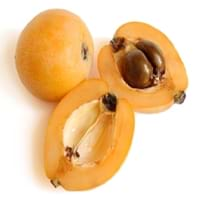jeruk nipis dan Loquat
Manfaat
Keuntungan sehat
pengobatan arthritis, pengobatan kolera, pengobatan asam urat, perawatan jantung, pengobatan tumpukan, pengobatan penyakit kudis
pencegahan kanker, perawatan jantung, Mengurangi ketegangan saraf, Mengurangi masalah sirkulasi darah, mengurangi stres, Peraturan denyut jantung, Penguatan tulang
Manfaat Umum
menyembuhkan demam, bantuan pencernaan, Perawatan mata, Menjaga tingkat kolesterol yang sehat, Pengobatan flu biasa
sifat anti-inflamasi, Kontrol tekanan darah, bantuan pencernaan, Perawatan mata, Membantu dalam penurunan berat badan, Meningkatkan visi mata, Menjaga tingkat kolesterol yang sehat, menguatkan tulang
Manfaat kulit
manfaat anti-penuaan, peremajaan kulit, Pengobatan jerawat, Pengobatan bintik-bintik gelap
manfaat anti-penuaan, mengurangi keriput, Pengobatan bintik-bintik gelap, Pengobatan penyakit kulit
Manfaat rambut
Mempromosikan lagi dan rambut sehat, Pengobatan ketombe
melindungi rambut
Alergi
Gejala alergi
kesulitan bernapas, Batuk, iritasi mata, hives, Peradangan, Hidung tersumbat, ingusan, Ruam kulit, mengi
Diare, Gatal mulut, Hidung tersumbat, Bersin, Pembengkakan wajah, Mata berair
Efek samping
Kemungkinan sengatan matahari
Reaksi alergi
recommeded untuk
Wanita hamil
iya nih
iya nih
Wanita menyusui
Tidak
iya nih
Waktu terbaik untuk makan
Seiring dengan makanan, Terbaik untuk minum air hangat dengan jeruk nipis pada perut kosong, Jangan mengkonsumsi pada malam hari dan sebelum tidur
Seiring dengan makanan, Sebagai camilan di sore hari, Jangan mengkonsumsi pada malam hari dan sebelum tidur, waktu pagi hari (sebelum makan siang)
Nutrisi
melayani Ukuran
100 gram
100 gram
Karbohidrat
10,50 g
99+
12,14 g
40
Serat
2,80 g
22
1,70 g
29
Gula
1,70 g
99+
Tidak tersedia
protein
0,70 g
99+
0,40 g
99+
Protein untuk carb Ratio
0,07
20
0,03
25
vitamin
Vitamin A (Retinol)
2,00 mcg
33
76,00 mcg
8
Vitamin B1 (Thiamin)
0,03 mg
31
0,02 mg
39
Vitamin B2 (Riboflavin)
0,02 mg
38
0,02 mg
35
Vitamin B3 (Niacin)
0,20 mg
99+
0,18 mg
99+
Vitamin B5 (Pantothenic Acid)
0,22 mg
27
Tidak tersedia
Vitamin B6 (piridoksina)
0,05 mg
39
0,10 mg
15
Vitamin B9 (asam folat)
8,00 mcg
27
14,00 mcg
21
Vitamin C (asam askorbat)
29,10 mg
30
Tidak tersedia
Vitamin E (Tocopherole)
0,22 mg
28
Tidak tersedia
Vitamin K (Phyllochinone)
0,60 mcg
31
Tidak tersedia
lycopene
0,00 mcg
9
Tidak tersedia
lutein + zeaxanthin
0,00 mcg
36
Tidak tersedia
kolin
5,10 mg
24
Tidak tersedia
Lemak
0,20 g
33
0,20 g
33
bahan galian
Kalium
102,00 mg
99+
266,00 mg
24
Besi
0,60 mg
21
0,28 mg
37
Sodium
2,00 mg
18
1,00 mg
20
Kalsium
33,00 mg
13
16,00 mg
25
Magnesium
6,00 mg
29
13,00 mg
22
Seng
0,11 mg
22
0,05 mg
28
Fosfor
18,00 mg
27
27,00 mg
19
manggan
0,01 mg
99+
0,15 mg
22
Tembaga
0,07 mg
35
0,04 mg
99+
selenium
0,40 mcg
13
0,60 mcg
10
Asam lemak
omega 3s
19,00 mg
25
13,00 mg
28
6s Omega
36,00 mg
40
77,00 mg
26
sterol
phytosterol
Tidak tersedia
2,00 mg
15
Kandungan air
88,26 g
17
86,73 g
29
Abu
0,30 g
38
0,50 g
26
kalori
melayani Ukuran
100 gram
100 gram
Kalori di Buah Segar dengan Peel
Tidak tersedia
47,00 kkal
26
Kalori di Buah Segar tanpa Peel
30,00 kkal
23
Tidak tersedia
Kalori di Frozen Form
Tidak tersedia
Tidak tersedia
Kalori dalam Formulir Kering
Tidak tersedia
Tidak tersedia
Kalori dalam Formulir Kaleng
20,68 kkal
26
67,00 kkal
16
Kalori dalam Makanan
Kalori dalam Juice
30,00 kkal
38
Tidak tersedia
Kalori di Jam
250,00 kkal
19
Tidak tersedia
Kalori di Pie
420,00 kkal
2
Tidak tersedia
karakteristik
Mengetik
Jeruk, buah pohon
buah pohon, Tropis
Musim
Semua musim
Musim dingin
varietas
jeruk nipis, Persia kapur, Jeruk purut, Desert kapur, Palestina Sweet Lime, Meksiko Sweet Lime, Mary Ellen Sweet Lime
Ahdar, Ahmar, Asfar, Blush, Champagne, Awal Merah, Eulalia, Fire Ball, Golden Red, Golden Yellow, Oliver, Thales, Thames Pride, Victor dan Wolfe
tanpa biji Ragam
iya nih
Tidak
Warna
hijau
Jeruk, Kuning
Di dalam Warna
Hijau muda
Jeruk
Bentuk
Bulat
Lonjong
Tekstur
Lezat
Berair
Rasa
asam, Asam
Manis, kue tar
Asal
India
Cina
tumbuh pada
pohon
pohon
Penanaman
Jenis tanah
liat lempung, lempung berpasir
Tanah liat, Lempung, Pasir, Baik dikeringkan
pH tanah
6-7.5
5.5-6.5
Kondisi iklim
Cerah, Hangat untuk iklim panas
Hangat untuk iklim panas
fakta
Fakta tentang
- Kapur yang disebut sebagai pusat kekuatan rasa.
- jeruk nipis segar sangat asam yang dapat melarutkan beton.
- Limes lebih harum dan asam dari lemon.
- limes Persia hampir tanpa biji dan duri kurang.
- Loquats digunakan dalam pembuatan anggur prem.
- daun kering dari loquat digunakan untuk membuat teh herbal.
- Benih-benih loquat sedikit beracun dan gejala keracunan adalah mual, muntah dan sesak napas.
Dalam Minuman Beralkohol
Anggur
iya nih
iya nih
Bir
iya nih
iya nih
Spirits
iya nih
iya nih
cocktails
iya nih
iya nih
Produksi
Top Producer
Cina
Jepang
Negara-negara lain
Argentina, Brazil, India, Mexico
Brazil, Chili, Cina, Mesir, Israel, Italia, Maroko, Pakistan, Portugal, Spanyol, Turki
Top Importir
Amerika Serikat
Cina
Top Eksportir
Mexico
Spanyol
Nama ilmiah
Nama botani
Citrus aurantifolia
Eriobotrya japonica
Sinonim
tidak tersedia
Crataegus Bibas atau Mespilus japonica atau Photinia japonica
Klasifikasi
Domain
Eukarya
Eukarya
Kerajaan
Plantae
Plantae
subkingdom
Tracheobionta
Tracheobionta
Divisi
Magnoliophyta
Magnoliophyta
Kelas
Magnoliopsida
Magnoliopsida
subclass
Rosidae
Rosidae
Memesan
Sapindales
Rosales
Keluarga
Rutaceae
Rosaceae
Marga
Jeruk
Eriobotrya
Jenis
C. aurantifolia
E. japonica
generik Grup
Buah jeruk
Mawar
|
||
|
||
|












